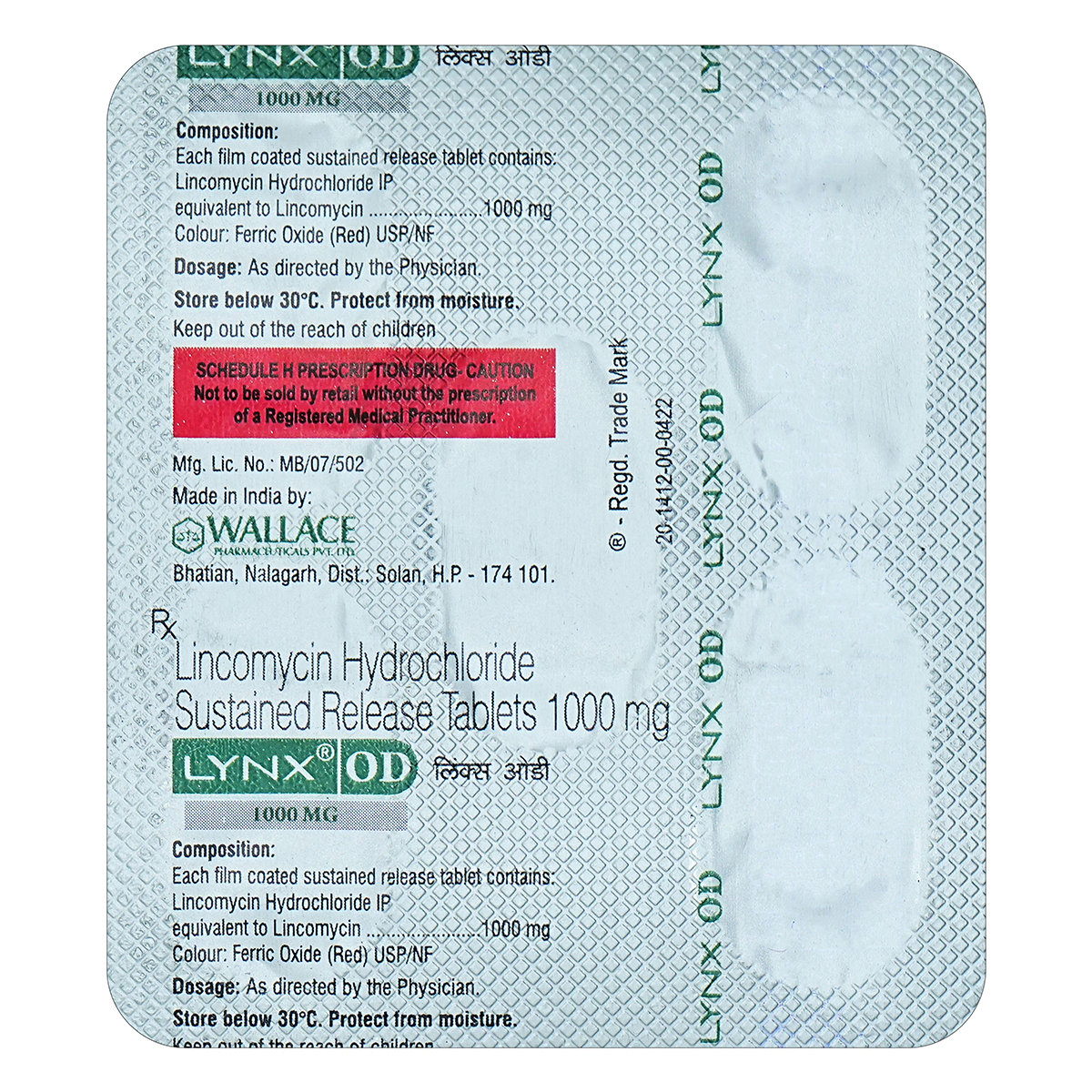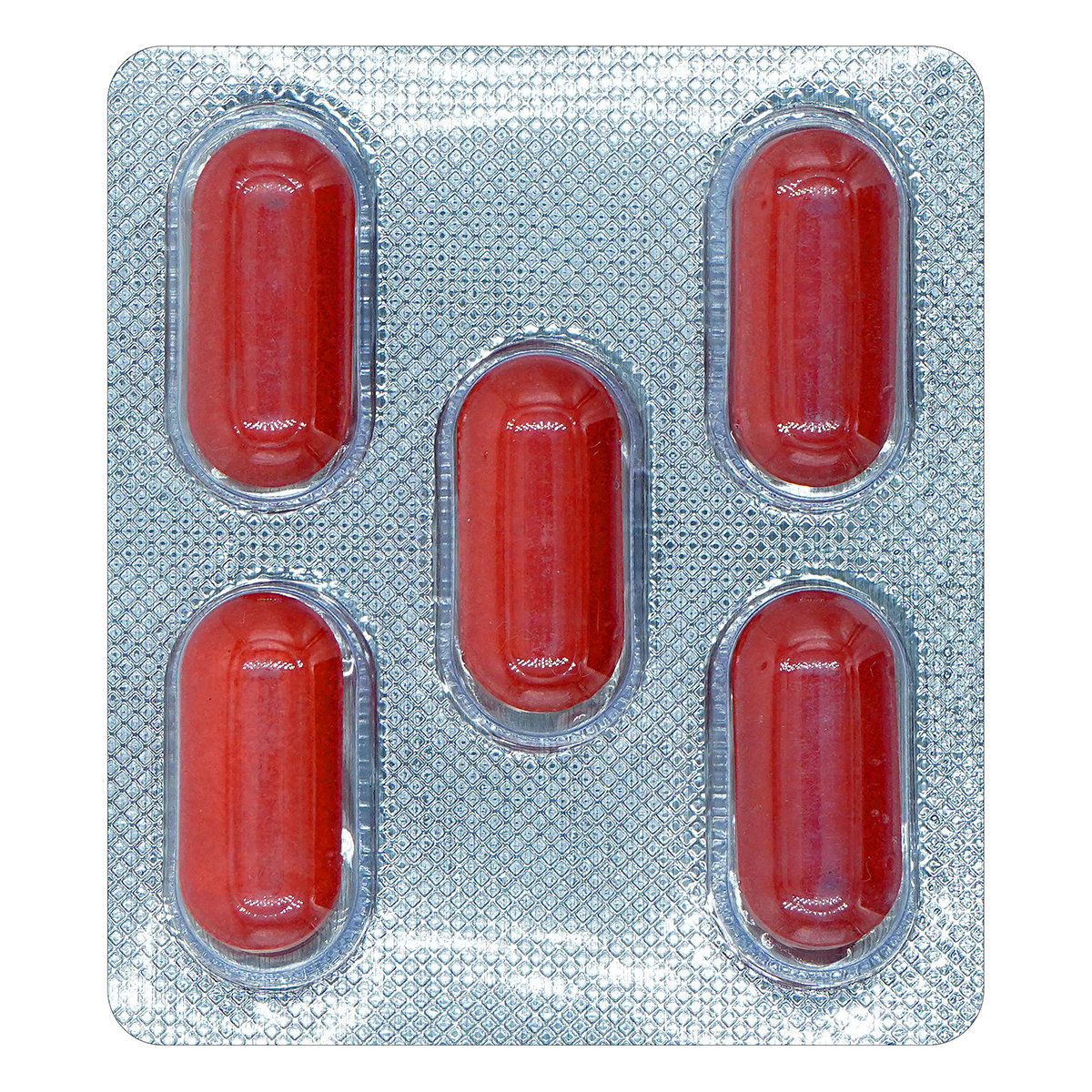Lynx OD 1000 mg Tablet


MRP ₹203
(Inclusive of all Taxes)
₹30.4 Cashback (15%)
know your delivery time
Provide Delivery Location
Composition :
Manufacturer/Marketer :
Consume Type :
Expires on or after :
Return Policy :

Secure Payment

Trusted by 8 Crore Indians

Genuine Products
Therapeutic Class
Country of origin
Manufacturer/Marketer address
Author Details
We provide you with authentic, trustworthy and relevant information
Disclaimer
Alcohol
Safe if prescribed
The interaction of alcohol with Lynx OD 1000 mg Tablet is unknown. However, it is advised to avoid alcohol consumption as it may cause dizziness and drowsiness. Please consult a doctor if you have any concerns regarding this.
Pregnancy
Consult your doctor
There have been no well-controlled studies on pregnant women. Please inform your doctor if you are pregnant or planning pregnancy before taking Lynx OD 1000 mg Tablet. Your doctor prescribes this medicine if the benefits outweigh the risks.
Breast Feeding
Consult your doctor
Lynx OD 1000 mg Tablet is excreted in breast milk in small amounts. Therefore, if you are a breastfeeding mother, please inform your doctor before taking Lynx OD 1000 mg Tablet. Your doctor prescribes this medicine if the benefits outweigh the risks.
Driving
Safe if prescribed
Lynx OD 1000 mg Tablet usually does not affect the ability to drive or operate machinery.
Liver
Consult your doctor
If you have liver disease/condition, inform your doctor before taking Lynx OD 1000 mg Tablet. The dose may be adjusted by your doctor as required.
Kidney
Consult your doctor
If you have kidney disease/condition, inform your doctor before taking Lynx OD 1000 mg Tablet. The dose may be adjusted by your doctor as required.
Children
Safe if prescribed
Lynx OD 1000 mg Tablet should be used in children only if a doctor prescribes it. Your doctor will decide the dose of this medicine based on the age, body weight and condition of your child.
About Lynx OD 1000 mg Tablet
Lynx OD 1000 mg Tablet belongs to a class of drugs called antibiotics used in the treatment of bacterial infections of the ear, nose, throat, respiratory tract, gastrointestinal tract, biliary tract, bone and joint, skin and soft tissue, furuncles (boils), secondary wound infections, gynecological infection and sepsis (blood poisoning). Bacterial infection is a condition in which harmful bacteria grow in the body and cause infection. It can infect any part of the body and multiply very quickly.
Lynx OD 1000 mg Tablet contains Lincomycin which works by inhibiting the production of essential proteins that are necessary for bacteria to grow, multiply and increase in numbers. Thus, Lynx OD 1000 mg Tablet destroys bacteria.
Take Lynx OD 1000 mg Tablet as prescribed. Your doctor will advise you on how often you take Lynx OD 1000 mg Tablet based on your medical condition. In some cases, you may experience vomiting, nausea, diarrhea, stomach pain, dizziness, or ringing in the ear. Most of these side effects of Lynx OD 1000 mg Tablet do not require medical attention and gradually resolve over time. However, if the side effects persist or worsen, please consult your doctor.
Please tell your doctor if you are allergic to Lincomycin or other medicines. If you are pregnant or breastfeeding, please inform your doctor before taking Lynx OD 1000 mg Tablet. Lynx OD 1000 mg Tablet should be used with caution in children and only in doses advised by a doctor. If you had diarrhoea previously after receiving or taking antibiotics, inform your doctor before taking Lynx OD 1000 mg Tablet. If you have kidney problems or are undergoing dialysis, inform your doctor before taking Lynx OD 1000 mg Tablet.
Uses of Lynx OD 1000 mg Tablet
Medicinal Benefits Mweb
Key Benefits
Lynx OD 1000 mg Tablet contains Lincomycin, a broad-spectrum antibiotic that acts against aerobic (grow in the presence of oxygen) and anaerobic (grow in the absence of oxygen) gram-negative and gram-positive bacteria. Lynx OD 1000 mg Tablet is used in the treatment of bacterial infections of the ear, nose, throat, respiratory tract, gastrointestinal tract, biliary tract, bone and joint, skin and soft tissue, furuncles (boils), secondary wound infections, gynaecological infection and sepsis (blood poisoning). Also, it is used as a concomitant treatment in surgery and for preoperative prevention.
Directions for Use
Side Effects of Lynx OD 1000 mg Tablet
- Vomiting
- Nausea
- Diarrhea
- Stomach pain
- Dizziness
- Ringing in the ear
Drug Warnings
Please tell your doctor if you are allergic to Lincomycin or other medicines. If pregnant or breastfeeding, please inform your doctor before taking Lynx OD 1000 mg Tablet. Lynx OD 1000 mg Tablet should be used with caution in children and only in doses advised by a doctor. If you had diarrhoea previously after receiving or taking antibiotics, inform your doctor before taking Lynx OD 1000 mg Tablet. If you have kidney problems or are undergoing dialysis, inform your doctor before taking Lynx OD 1000 mg Tablet.
Drug-Drug Interactions
Drug-Drug Interactions
Login/Sign Up
Drug-Food Interactions
Drug-Food Interactions
Login/Sign Up
Drug-Diseases Interactions
Drug-Diseases Interactions
Login/Sign Up
Drug-Drug Interactions Checker List
- ERYTHROMYCIN
Habit Forming
Special Advise
During long-term treatment with Lynx OD 1000 mg Tablet, regular monitoring of liver, kidney, and haematopoietic (formation of new blood cells) function is recommended.
Diet & Lifestyle Advise
- Take probiotics after completing the full course of Lynx OD 1000 mg Tablet to restore some healthy bacteria in the intestines that may have been killed. Taking probiotics after antibiotic treatment can reduce the risk of antibiotic-associated diarrhoea. Certain fermented foods like c-cheese, yogurt, kombucha, sauerkraut, and kimchi can help to restore the good bacteria of the intestine.
- Include fiber-rich foods, as they can be easily digested by your gut bacteria, which helps stimulate their growth. Thus, fibre-rich foods may help restore healthy gut bacteria after a course of antibiotics. Whole grains such as whole-grain bread and brown rice should be included in your diet.
- Maintain a low-sodium diet as Lynx OD 1000 mg Tablet in injection form may increase sodium levels in the blood.
- Make sure you drink plenty of water or other fluids daily while taking Lynx OD 1000 mg Tablet.

Have a query?
Buy best Infections & Infestation products by
Cipla Ltd
Macleods Pharmaceuticals Ltd
Alkem Laboratories Ltd
Lupin Ltd
Abbott India Ltd
Sun Pharmaceutical Industries Ltd
Mankind Pharma Pvt Ltd
Micro Labs Ltd
Aristo Pharmaceuticals Pvt Ltd
FDC Ltd
Intas Pharmaceuticals Ltd
Glenmark Pharmaceuticals Ltd
Ipca Laboratories Ltd
Torrent Pharmaceuticals Ltd
Zydus Healthcare Ltd
Biochem Pharmaceutical Industries Ltd
Zuventus Healthcare Ltd
United Biotech Pvt Ltd
Hetero Drugs Ltd
Emcure Pharmaceuticals Ltd
Alembic Pharmaceuticals Ltd
Indoco Remedies Ltd
Fusion Health Care Pvt Ltd
Dr Reddy's Laboratories Ltd
Leeford Healthcare Ltd
Cadila Healthcare Ltd
Wockhardt Ltd
Zydus Cadila
GlaxoSmithKline Pharmaceuticals Ltd
Morepen Laboratories Ltd
Blue Cross Laboratories Pvt Ltd
Cadila Pharmaceuticals Ltd
Converge Biotech Pvt Ltd
Elder Pharmaceuticals Ltd
Hetero Healthcare Pvt Ltd
Pfizer Ltd
AAA Pharma Trade Pvt Ltd
Gufic Bioscience Ltd
Mylan Pharmaceuticals Pvt Ltd
Corona Remedies Pvt Ltd
Wallace Pharmaceuticals Pvt Ltd
Apex Laboratories Pvt Ltd
Medishri Healthcare Pvt Ltd
Akumentis Healthcare Ltd
Alniche Life Sciences Pvt Ltd
Hegde & Hegde Pharmaceutica Llp
Veritaz Healthcare Ltd
Ranbaxy Laboratories Ltd
Koye Pharmaceuticals Pvt Ltd
Shreya Life Sciences Pvt Ltd
Overseas Health Care Pvt Ltd
Biocon Ltd
Indchemie Health Specialities Pvt Ltd
Medley Pharmaceuticals Ltd
Brinton Pharmaceuticals Ltd
J B Chemicals & Pharmaceuticals Ltd
Unifaith Biotech Pvt Ltd
Ajanta Pharma Ltd
Biochemix Health Care Pvt Ltd
Natco Pharma Ltd
Samarth Life Sciences Pvt Ltd
Unichem International
Laborate Pharmaceuticals India Ltd
Unipark Biotech Pvt Ltd
Zymes Bioscience Pvt Ltd
Indiabulls Pharmaceuticals Pvt Ltd
Neon Laboratories Ltd
Vasu Organics Pvt Ltd
DR Johns Lab Pharma Pvt Ltd
East West Pharma India Pvt Ltd
La Renon Healthcare Pvt Ltd
Medgen Drugs And Laboratories Pvt Ltd
Novartis India Ltd
Canixa Life Sciences Pvt Ltd
Icarus Health Care Pvt Ltd
Lincoln Pharmaceuticals Ltd
Celon Laboratories Pvt Ltd
Concept Pharmaceuticals Ltd
Klm Laboratories Pvt Ltd
Nicholas Piramal India Ltd
Systopic Laboratories Pvt Ltd
Yuventis Pharmaceuticals
Capital Pharma
German Remedies Ltd
Pristine Pearl Pharma Pvt Ltd
Unison Pharmaceuticals Pvt Ltd
Aurz Pharmaceutical Pvt Ltd
Clover Health Care Pharma
Kepler Healthcare Pvt Ltd
Allites Life Sciences Pvt Ltd
Auspharma Pvt Ltd
Intra Life Pvt Ltd
Jolly Healthcare
Linux Laboratories Pvt Ltd
Ozone Pharmaceuticals Ltd
Cachet Pharmaceuticals Pvt Ltd
Comed Chemicals Ltd
Delcure Life Sciences Ltd
Fresenius Kabi India Pvt Ltd
Khandelwal Laboratories Pvt Ltd
Customers Also Bought




